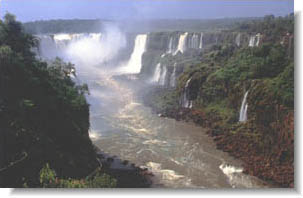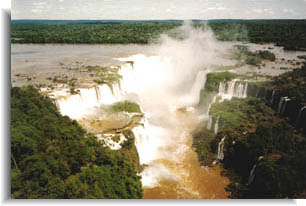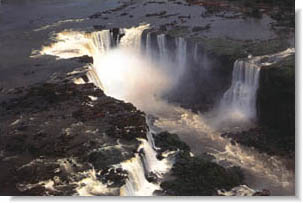
I started this exciting trip from Vladivostok airport on August 18, 2000. My mom and brother came to the airport to see me off.
This time I also traveled with Aeroflot Russian International Airlines. It took me almost 9 hours to reach Moscow from Vladivostok. Six hours later I entered the aircraft leaving to São Paolo. Our Iljushin-96 headed to Tunis and in 4 hours I enjoyed being in Tunis Carthage International Airport. One hour later we were finally on the last leg of our flight and in other 11 hours our plane landed in Guarulhos São Paolo International Airport. With the help of my colleague I moved to the bus station (Rodoviaria) and spent another 14 hours travelling by bus. On the 20th of August 2000, 30 hours after departure from Vladivostok, I reached Foz do Iguaçu hosting XXI International Congress of Entomology.
It was the first day of the congress. I registered, picked up my badge, got settled in Rafain Centro hotel (many thanks to Prof. Sperling for that) and went to make a tour of the falls.
Iguassu Falls (Cataratas do Iguaçu) are located in a subtropical region just in the border of Brazil, Argentina and Paraguay. The Parana River, one of the largest world rivers, runs along the frontier of Brazil and Argentina and Brazil and Paraguay. The Iguaçu River crosses all Parana State from East to West until encountering the Parana River. But, 5 km before, the Iguaçu River forms a tremendous set of about 270 cascades, from small to large ones, including the magnificent Devil's Throat (Garganta do Diablo), where thousand of liters of water fall each second, forming clouds and a breathtaking sound. The falls are over 3 kilometers (2 miles) wide and 80 meters (260 feet) high, which makes them wider than Victoria, higher than Niagara, and more beautiful than either.
These falls are 60 feet higher than Niagara and about one and a half times as wide. Eleanor Roosevelt is said to have exclaimed on first seeing these falls: "Poor Niagara! This makes Niagara look like a kitchen faucet."
The Iguassu falls besides being the major tourist attraction provides employment for 70 per cent of the population.
The falls are without a doubt majestic and breathtaking and are unequally divided between Brazil and Argentina. To see them properly, one must visit both sides. In Brazil you get the grand overview and in Argentina you get a closer look.
My first tour was to the Argentinian side of the falls. Entry visa is not required if you just want to see the falls. I made this trip with other participants of the congress just paying a fee to cross the board. We had long bus ride through Iguassu National Park until we reached the water. To get close to the falls, we were boated to a catwalk bridge leading to the sighting point. As I saw on the old pictures, formerly, the bridge extended till the bank but was evidently destroyed at the time of flood.
I stood on the bridge less than one meter above the water and watched the mild stream, which took a sudden change of character and with a mighty roar, plunged deep down. It is unbelievable, but I was standing at the lip of the Devil's Throat deafened by crashing water.
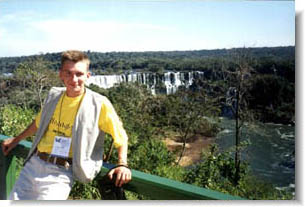
Next time I visited Brazilian side of the falls.
The falls were not that far from where I stood, I could clearly see tourists walking over the bridge over the falls in Argentina from here, and the flock of vultures circling over them, at an altitude. As I walked along the curved path, tall trees on either side created a green tunnel so that I was protected from the sun, I saw more and more falls.
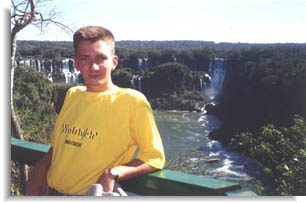
The path led me into a walkway, jutting into a tier of the falls. I felt like if I were in a boat at the middle of the river, surrounded on all 270 degrees by falls of different sizes and shapes. When I looked up from where I stood, I saw thick sheets of water, very wide, as they came crashing onto the brown boulders, spraying water droplets, striking my face and drenching me in just a few seconds.
Neither words nor photographs do the falls justice - they must be seen and heard in person.
>>